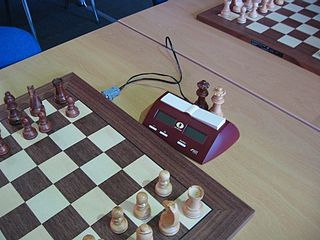Baroque chess is a chess variant invented in 1962 by Robert Abbott. In 1963, at the suggestion of his publisher, he changed the name to Ultima, by which name it is also known. Abbott later considered his invention flawed and suggested amendments to the rules, but these suggestions have been substantially ignored by the gaming community, which continues to play by the 1962 rules. Since the rules for Baroque were first laid down in 1962, some regional variation has arisen, causing the game to diverge from Ultima.

The queen is the most powerful piece in the game of chess. It can move any number of squares vertically, horizontally or diagonally, combining the powers of the rook and bishop. Each player starts the game with one queen, placed in the middle of the first rank next to the king. Because the queen is the strongest piece, a pawn is promoted to a queen in the vast majority of cases.

A chess piece, or chessman, is a game piece that is placed on a chessboard to play the game of chess. It can be either white or black, and it can be one of six types: king, queen, rook, bishop, knight, or pawn.
Circe chess is a chess variant in which captured pieces return to their starting positions as soon as they are captured. The game was invented by French composer Pierre Monréal in 1967 and the rules of Circe chess were first detailed by Monréal and Jean-Pierre Boyer in an article in Problème, 1968. It is named for the enchantress Circe, who in the Odyssey instructs Odysseus on how to enter the Underworld and return, just as pieces in Circe chess can return after being killed.
Capablanca chess is a chess variant invented in the 1920s by World Chess Champion José Raúl Capablanca. It incorporates two new pieces and is played on a 10×8 board. Capablanca believed that chess would be played out in a few decades. This threat of "draw death" for chess was his main motivation for creating a more complex version of the game.
A fairy chess piece, variant chess piece, unorthodox chess piece, or heterodox chess piece is a chess piece not used in conventional chess but incorporated into certain chess variants and some unorthodox chess problems, known as fairy chess. Compared to conventional pieces, fairy pieces vary mostly in the way they move, but they may also follow special rules for capturing, promotions, etc. Because of the distributed and uncoordinated nature of unorthodox chess development, the same piece can have different names, and different pieces can have the same name in various contexts.
Martian Chess is an abstract strategy game for two or four players invented by Andrew Looney in 1999. It is played with Icehouse pyramids on a chessboard. To play with a number of players other than two or four, a non-Euclidean surface can be tiled to produce a board of the required size, allowing up to six players.

Vernon Rylands Parton was an English chess enthusiast and prolific chess variant inventor, his most renowned variants being Alice chess and Racing Kings. Many of Parton's variants were inspired by the fictional characters and stories in the works of Lewis Carroll. Parton's formal education background, like Lewis Carroll's, was in mathematics. Parton's interests were wide and he was a great believer in Esperanto.

Sittuyin, also known as Burmese chess, is a strategy board game created in Myanmar. It is a direct offspring of the Indian game of chaturanga, which arrived in Myanmar in the 8th century thus it is part of the same family of games such as chess, and shogi. Sit is the modern Burmese word for "army" or "war"; the word sittuyin can be translated as "representation of the four characteristics of army"—chariot, elephant, cavalry and infantry.
In chess and other related games, a double check is a check delivered by two pieces simultaneously. In chess notation, it is almost always represented the same way as a single check ("+"), but is sometimes symbolized by "++". This article uses "++" for double check and "#" for checkmate.

In chess, promotion is the replacement of a pawn with a new piece when the pawn is moved to its last rank. The player replaces the pawn immediately with a queen, rook, bishop, or knight of the same color. The new piece does not have to be a previously captured piece. Promotion is mandatory when moving to the last rank; the pawn cannot remain as a pawn.

Hexagonal chess is a group of chess variants played on boards composed of hexagon cells. The best known is Gliński's variant, played on a symmetric 91-cell hexagonal board.

Minichess is a family of chess variants played with regular chess pieces and standard rules, but on a smaller board. The motivation for these variants is to make the game simpler and shorter than standard chess. The first chess-like game implemented on a computer was the 6×6 chess variant Los Alamos chess. The low memory capacity of early computers meant that a reduced board size and a smaller number of pieces were required for the game to be implementable on a computer.
Monochromatic chess is a chess variant with unknown origin. The initial board position and all rules are the same as in regular chess, except that pieces that begin on a black square must always stay on a black square and pieces that begin on a white square must always stay on a white square. This would mean that knights can never move, but The Classified Encyclopedia of Chess Variants says that knights make a double jump. It has been suggested that a knight be replaced with a (3,1)-leaper (camel).
Omega Chess is a commercial chess variant designed and released in 1992 by Daniel MacDonald. The game is played on a 10×10 board with four extra squares, each added diagonally adjacent to the corner squares. The game is laid out like standard chess with the addition of a champion in each corner of the 10×10 board and a wizard in each new added corner square.

The following outline is provided as an overview of and topical guide to chess:

Chesquerque is a chess variant invented by George R. Dekle Sr. in 1986. The game is played on a board composed of four Alquerque boards combined into a square. Like Alquerque, pieces are positioned on points of intersection and make their moves along marked lines ; as such, the board comprises a 9×9 grid with 81 positions (points) that pieces can move to.

Falcon–hunter chess is a chess variant invented by Karl Schultz in 1943, employing the two fairy chess pieces falcon and hunter. The game takes several forms, including variations hunter chess and decimal falcon–hunter chess added in the 1950s.

Congo is a chess variant invented by Demian Freeling in 1982 when he was nearly 8 years old. His father encouraged him to design a variant using a 7×7 gameboard. Demian was already familiar with chess and xiangqi, and the result blends some features from both. Congo became the second-most popular chess variant at the Fanaat games club in Enschede, the Netherlands.











